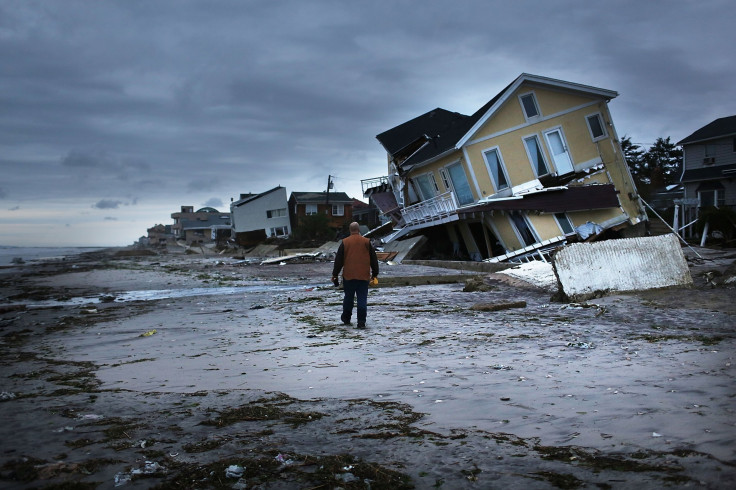Hurricane Sandy Anniversary: Changing Global Climate Means More Superstorms Like Sandy

When Hurricane Sandy slammed into the Northeast on Oct. 29, 2012 -- engulfing homes and crippling communities -- many people billed it as a once-in-a-lifetime, freak event. But as the floodwaters subsided and life creaked back to normal, city officials, scientists and beleaguered residents began to recognize Sandy as something more: A wake-up call to a new world altered by climate change and lacking in the most modern protective measures.
The storm revealed in devastating detail just how vulnerable coastal communities are to harsh weather patterns, storm surges and powerful flooding -- all of which are likely to become more frequent and intense over time as the planet warms and sea levels rise.
“Sandy reminded us that the unexpected can and does happen … and that the unexpected is going to be happening more often in the future," Radley M. Horton, a climate scientist at Columbia University's Earth Institute in New York, says.
Yet two years after Sandy, most East Coast cities remain just as exposed to extreme events as they were before the storm. Real estate development continues to spread along the waterfront, and many municipal plans to defend against encroaching seas -- including wetlands restoration projects and concrete floodgate construction -- have yet to be put into action. Crumpled homes and gutted shops are being rebuilt with little to keep them from flooding again.
If coastal communities fail to prepare for these coming changes, the effect on livelihoods and local economies could be devastating, environmental experts say.
Sandy racked up $71 billion in damages to homes, buildings and critical infrastructure and in economic losses from shuttered businesses. It's the second-costliest weather disaster in U.S. history behind 2005's Hurricane Katrina. But in the future, it won't take a Sandy-level event to cause the same scale of destruction. Weaker storms will be just as damaging, since sea level rise will make it easier for waves and rains to cause a catastrophic deluge, Horton says.
Sandy itself is proof of this phenomenon, according to the New York City Panel on Climate Change, of which Horton is a member. Since 1900, sea level in New York has risen 1.1 feet -- at nearly twice the rate of the rest of the world. (Changes in sea levels vary between locations, depending on a host of factors, including ocean current variations and sinking land mass.)
During Sandy, the added ocean height “increased the extent and the magnitude of coastal flooding,” the panel wrote in a June 2013 climate risk assessment. “As sea levels continue to rise, coastal flooding will occur more frequently, and future coastal storms will cause more flood damage than they otherwise would have,” the report cautioned.
The panel attributed the existing sea level rise primarily to climate change. Scientific evidence has shown that over the past century, the burning of fossil fuels for energy and transportation, the clearing of forests and other industrial activities have spewed enormous amounts of greenhouse gases into the atmosphere. All these heat-trapping emissions have caused the Earth’s surface and ocean temperatures to rise, which is simultaneously melting land-based ice and causing ocean waters to expand; both in turn elevate the sea level.
With global warming expected to accelerate over the rest of this century, sea levels too will rise at a faster clip. In New York alone, sea levels could rise by as much as 2.5 feet by the mid-2050s, according to the city climate panel’s high-end projections.
At that height, about one-quarter of the city -- or 72 square miles -- would fall into a “100-year” floodplain, meaning an area that has a 1 percent chance of flooding each year, according to “future flood maps” published in New York’s Special Initiative on Rebuilding and Resiliency report.
The Sept. 11 memorial plaza, the New York Stock Exchange, the Coney Island boardwalk and Yankee Stadium would all fall into the danger zone. The area is home to more than 800,000 New Yorkers, or about one-tenth of the city’s population.
By the end of the century, New York’s sea levels could rise by as much as 5.5 feet, geoscientists at Rutgers and Tufts universities concluded in a December 2013 study. That would flood every subway tunnel that connects Manhattan to Brooklyn and Queens and eat away at the LaGuardia and Kennedy Airports.
And yet rising seas aren’t even the only climate impact New Yorkers are facing. The city is likely to suffer heavier and more frequent rainfall, which could lead to clogged sewers, overtaxed drainage systems and inundated streets -- unless the city adapts to changes, the climate panel found. Heat waves will become more frequent and severe, which could threaten health and stress the electrical grid as residents blast air conditioners.
If all of these climate threats once seemed distant and uncertain, Sandy has made them painfully real. In the storm’s wake, New York and other coastal cities have begun scrambling to develop long-term strategies for protecting citizens and infrastructure from storms, flooding, deadly hot summers and other effects.
“We can’t wait until the next storm hits to pay for future mitigation,” William S. Nechamen, New York State's floodplain chief, recently told reporters.
© Copyright IBTimes 2025. All rights reserved.





















